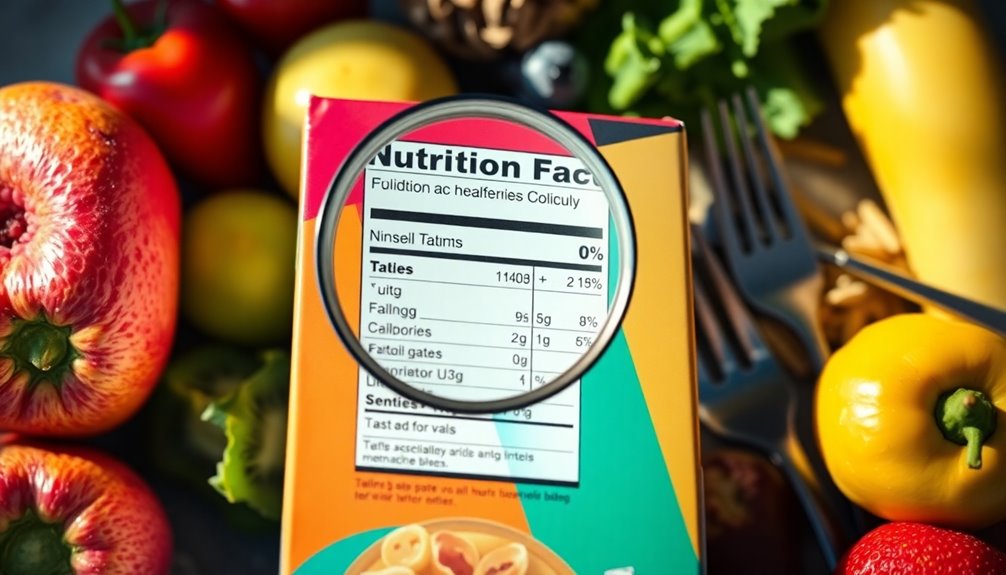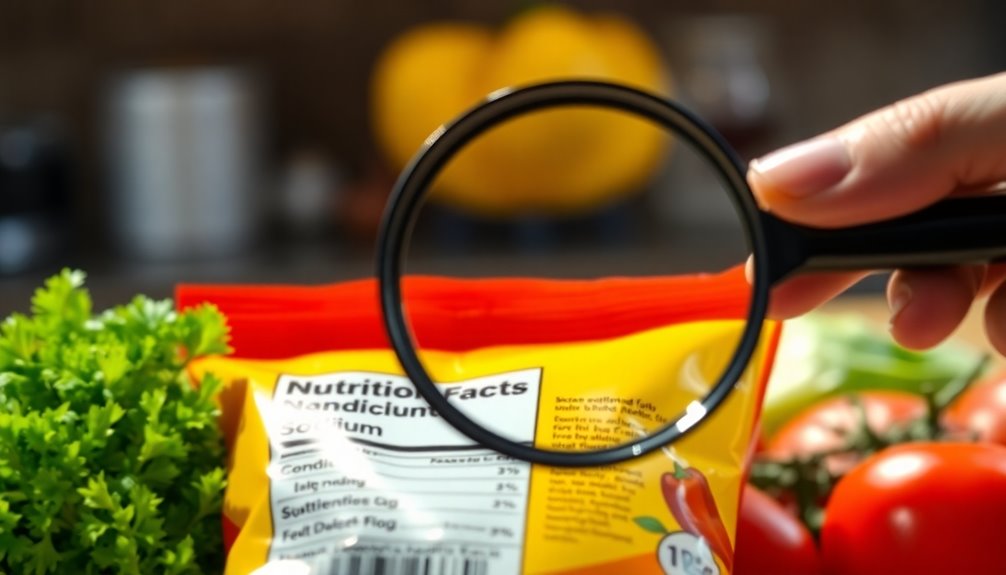To effectively understand nutrition facts labels, start by checking the serving size; it determines portions and helps you manage calorie intake. Next, look at total calories and examine macronutrients like carbohydrates, proteins, and fats. Keep an eye out for added sugars, aiming for lower amounts. Don't forget to monitor sodium and key vitamins, as these are vital for your health. Compare similar products to make better choices, and recognize health claims to avoid misleading labels. Finally, use the % Daily Value to gauge nutrient contributions. Stick around to discover more tips for making healthier choices!
Key Takeaways
- Always check the serving size to ensure accurate comparison of calorie and nutrient intake against what you actually consume.
- Look for % Daily Value (%DV) to evaluate how a food contributes to your daily nutritional needs, aiming for higher %DVs for beneficial nutrients.
- Identify and limit added sugars by checking ingredient lists for terms like syrup and glucose, keeping within recommended daily limits.
- Monitor sodium content, seeking products with less than 140 mg per serving to support heart health and prevent high blood pressure.
- Compare similar products' nutrition labels to make healthier choices, focusing on lower calories, saturated fats, and higher fiber content.
Understand Serving Sizes

Serving sizes can be tricky, but they're crucial for managing your diet effectively. When you look at a nutrition label, the serving size tells you how much of that food is considered one portion. It's easy to underestimate or overestimate what a serving really is, especially with foods that come in larger packages.
To make the most of this information, always compare the serving size to how much you actually eat. If you're pouring a bowl of cereal, for instance, check if what you're pouring matches the recommended serving size. If it doesn't, adjust your intake accordingly or be mindful of how that affects your overall nutrition.
Another tip is to remember that serving sizes can vary between products. Just because one brand of yogurt has a serving size of 150 grams doesn't mean another brand will too. Take the time to read each label, and don't rely on assumptions. Additionally, knowing the right plant food can help you maintain healthy eating habits that align with your nutrition goals.
Finally, keep in mind that serving sizes aren't recommendations for how much to eat but rather standard measurements. Use them as a guide to help you make informed choices about your diet and portion control. Additionally, understanding the importance of caloric intake management can further assist you in making healthier food choices.
Check Total Calories
After you've got a handle on serving sizes, the next step is to check total calories. This number tells you how much energy you'll get from consuming that serving. It's essential to know this, especially if you're watching your weight or trying to maintain a balanced diet. Utilizing self-watering planters can also give you more time to focus on meal prep by reducing the need for frequent plant care.
When you look at the calorie count, consider how it fits into your daily caloric needs. For most adults, this can range from 1,800 to 2,400 calories per day, depending on factors like age, gender, and activity level. If you're aiming to lose weight, you'll want to create a calorie deficit, meaning you consume fewer calories than you burn.
Keep in mind that not all calories are equal. Some foods provide more nutrients relative to their calorie content, while others may be high in calories but low in essential nutrients. This is crucial when choosing snacks or meals. Additionally, opting for organic options can help ensure that you're consuming foods free from harmful pesticides, which aligns with a healthier lifestyle.
Lastly, don't forget to factor in how many servings you might eat. If you're planning to eat two servings, multiply the total calories by two to better assess how it affects your daily intake.
Examine Macronutrients

Understanding macronutrients is essential for making informed dietary choices. When you look at a nutrition facts label, you'll notice three key macronutrients: carbohydrates, proteins, and fats. Each of these plays a vital role in your overall health, and knowing how to read their values can help you meet your dietary needs.
Here are three important things to consider when examining macronutrients:
- Carbohydrates: Check the total carbs and fiber content. Aim for higher fiber options, as they can aid digestion and keep you feeling full longer.
- Proteins: Look at the protein amount to ensure you're getting enough to support muscle health and repair. This is particularly crucial if you're active or trying to build muscle.
- Fats: Not all fats are created equal. Focus on the types of fats listed, especially the saturated and trans fats. Opt for products with healthier fats, like monounsaturated and polyunsaturated fats, which can benefit heart health. Additionally, choosing products with nutrient-dense ingredients can further enhance your overall nutrition.
Look for Added Sugars
When you check a nutrition facts label, it's crucial to pay attention to added sugars. These sugars are included in many processed foods and can contribute to various health issues, including obesity and diabetes.
Unlike natural sugars found in fruits and dairy, added sugars don't provide any nutritional benefits. Instead, they just add empty calories to your diet.
To identify added sugars, look for terms like "syrup," "honey," "sucrose," "glucose," and "fructose" in the ingredient list. Even if a product claims to be "healthy" or "low-fat," it can still be high in added sugars.
Check the grams of added sugars listed on the label; the American Heart Association recommends limiting added sugars to about 6 teaspoons per day for women and 9 teaspoons for men.
When you choose products, aim for those with little to no added sugars. This can help you maintain stable energy levels and reduce cravings.
If you find a product with high added sugars, consider alternatives that are lower in sweetness or naturally sweetened. Making these mindful choices can significantly improve your overall health.
Identify Key Vitamins

Vitamins are essential nutrients that play a vital role in keeping your body functioning at its best. When you read nutrition facts labels, identifying key vitamins can help you make healthier choices.
Here are three important vitamins to look for:
- Vitamin A: This vitamin supports vision, immune function, and skin health. Foods rich in Vitamin A include carrots, sweet potatoes, and spinach.
- Vitamin C: Known for its immune-boosting properties, Vitamin C also helps with the absorption of iron and promotes healthy skin. Citrus fruits, strawberries, and bell peppers are excellent sources.
- Vitamin D: Crucial for bone health and calcium absorption, Vitamin D can be obtained from sunlight, fortified dairy products, and fatty fish.
When scanning labels, check for the % Daily Value (%DV) next to these vitamins. A %DV of 20% or more indicates a good source, while 5% or less is considered low.
Prioritizing these vitamins in your diet can enhance your overall health. So, make sure you're choosing foods that provide these key nutrients!
Analyze Fiber Content
As you explore nutrition facts labels, pay close attention to fiber content, an important component of a healthy diet. Fiber plays a crucial role in digestion, helping to maintain regular bowel movements, and can even aid in weight management by keeping you feeling fuller longer.
When analyzing fiber content, look for the total dietary fiber listed under the carbohydrates section. A good rule of thumb is to aim for products that contain at least 3 grams of fiber per serving. This amount can help you reach the recommended daily intake, which is about 25 grams for women and 38 grams for men.
Keep in mind that not all fiber is created equal; it comes in two types: soluble and insoluble. Soluble fiber can help lower cholesterol and stabilize blood sugar, while insoluble fiber promotes healthy digestion.
When you choose whole grains, fruits, vegetables, and legumes, you're likely to get a higher fiber content. Be cautious of processed foods that might claim to be high in fiber but contain added sugars or unhealthy fats.
Always strive for natural sources to maximize your fiber intake and support your overall health.
Watch Out for Sodium

Sodium is another key component to watch for on nutrition facts labels, as excessive intake can lead to high blood pressure and other health issues.
It's essential to monitor your sodium consumption to maintain a healthy lifestyle. Here are some tips to help you stay on track:
- Check the Serving Size: Always look at the serving size to understand how much sodium you're actually consuming. It can be misleading if you're consuming more than the listed amount.
- Aim for Lower Numbers: The American Heart Association recommends limiting sodium to 2,300 mg per day, ideally aiming for 1,500 mg. Choose products with lower sodium content—preferably under 140 mg per serving.
- Be Wary of Hidden Sodium: Many processed foods, sauces, and even snacks contain high levels of sodium. Don't just focus on salty foods; read the labels of all products to identify hidden sources.
Compare Similar Products
When you're trying to make healthier choices, comparing similar products can be a game changer. When you walk down the grocery aisle, take a moment to look at the nutrition labels of different brands or types of the same product. This simple step can help you spot significant differences in calories, fats, sugars, and other nutrients.
Start by focusing on the serving size. It's easy to overlook, but it can vary between products, which impacts the overall nutritional value.
Next, check the calories per serving. If you're watching your weight, a lower-calorie option might be better. Then, examine the fat content, especially saturated and trans fats, as these can affect heart health.
Don't forget to look at the sugar content, too. Some products may have added sugars that can be avoided.
Fiber content is another crucial factor; higher fiber usually means a more filling option.
Lastly, consider the ingredient list. A shorter list with recognizable ingredients is typically a sign of a healthier choice.
Recognize Health Claims

Health claims on food packaging can be misleading, so it's essential to recognize what they really mean. Just because a product boasts a health claim doesn't necessarily mean it's the healthiest choice.
Here are three types of claims you should know about:
- Nutrient Content Claims: These indicate the level of a nutrient in a product, like "low fat" or "high fiber." While they can be helpful, remember that a low-fat product may still be high in sugar.
- Health Claims: These suggest a relationship between a food and a health benefit, such as "may reduce heart disease." It's important to look for the scientific evidence backing these claims, as not all are created equal.
- Structure/Function Claims: These describe the role of a nutrient or ingredient in maintaining health, like "calcium builds strong bones." They're often less regulated, so they may not have strong evidence to support them.
Use the % Daily Value
Understanding health claims is just one part of making informed food choices. Another crucial aspect is the % Daily Value (%DV) listed on nutrition labels. This percentage helps you gauge how a food fits into your daily dietary needs. For example, if a food item has a %DV of 20% for calcium, it means that one serving provides 20% of the calcium you should aim for in a day.
Using the %DV can simplify your decision-making. Here's how you can interpret it:
| % Daily Value | Meaning |
|---|---|
| 5% or less | Low in that nutrient |
| 10-19% | Good source of that nutrient |
| 20% or more | Excellent source of that nutrient |
| 0% | No contribution to daily needs |
| 100% | Meets your daily requirement |
When you shop, aim for foods that provide higher %DVs for nutrients you want more of, like fiber and vitamins, while keeping an eye on those with lower %DVs for things like saturated fat and sodium. This way, you can make choices that align with your health goals.
Frequently Asked Questions
How Do I Interpret Different Serving Sizes Between Products?
To interpret different serving sizes, you'll need to compare the nutritional information based on those sizes. Always adjust the values according to the serving you actually consume to make informed choices about your diet.
Are Nutrition Labels Standardized Across All Food Products?
Nutrition labels aren't completely standardized across all food products. While they must follow FDA guidelines, variations exist due to different serving sizes, formats, and required information. You'll need to compare labels carefully for accurate insights.
What Do "Natural" and "Organic" Mean on Labels?
You might think "natural" means it's healthy, but that's misleading. "Natural" suggests minimal processing, while "organic" certifies no synthetic additives. Knowing these terms helps you make informed choices about what you eat.
How Often Are Nutrition Facts Updated or Changed?
Nutrition facts can change based on new research or regulations. Manufacturers typically update labels when recipes alter or when the FDA requires revisions. You should always check for the most current information when shopping.
Can I Rely Solely on Nutrition Labels for Healthy Eating?
Imagine a map guiding you through a dense forest. While nutrition labels provide valuable direction, you can't rely solely on them. Explore whole foods, listen to your body, and balance your choices for true nourishment.
Conclusion
By keeping these tips in mind, you'll navigate nutrition labels like a seasoned chef in a bustling kitchen. You're now equipped to sift through the clutter and uncover the gems of information that fuel your health journey. Remember, each label tells a story—one that can help you make informed choices and savor every bite. So, step confidently into the grocery aisle, armed with knowledge, and let your plate reflect the vibrant, healthy life you deserve!




